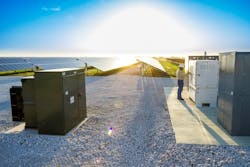PLT Energy and GGS Energy Form JV to Bring 1 GW of Renewable Energy to Texas
PLT Energy US Corp, a subsidiary of an Italian renewable energy and storage provider, has started a joint venture (JV) with GGS Energy to develop more than 1 GW of renewable energy in Texas.
The JV - PLT US Solar 1 LLC - will be 80% owned by PLT Energy and 20% owned by GGS Energy.
"This dynamic JV with GGS Energy offers PLT a platform for international growth into the US market and advances our long-term goals of being a leader in the realization of renewable energy projects globally," said Pierluigi Tortora, Chairman of PLT Energy.
Under the JV, the companies will work to develop and construct their first project - Indigo Project Phase I - located in West Texas. The project will total 330 MW and feature 150 MW of solar and 180 MW of storage. The JV expects construction to commence in June 2024.
"Joining hands with the PLT group heralds a new era for GGS Energy, where trust, innovation, and expertise converge to fuel our growth ambitions in the renewable energy sector," said GGS Energy CEO David Ramm.
About the Author
EnergyTech Staff
Rod Walton is head of content for EnergyTech.com. He has spent 17 years covering the energy industry as a newspaper and trade journalist.
Walton formerly was energy writer and business editor at the Tulsa World. Later, he spent six years covering the electricity power sector for Pennwell and Clarion Events. He joined Endeavor and EnergyTech in November 2021.
He can be reached at [email protected].
EnergyTech is focused on the mission critical and large-scale energy users and their sustainability and resiliency goals. These include the commercial and industrial sectors, as well as the military, universities, data centers and microgrids.
Many large-scale energy users such as Fortune 500 companies, and mission-critical users such as military bases, universities, healthcare facilities, public safety and data centers, shifting their energy priorities to reach net-zero carbon goals within the coming decades. These include plans for renewable energy power purchase agreements, but also on-site resiliency projects such as microgrids, combined heat and power, rooftop solar, energy storage, digitalization and building efficiency upgrades.
